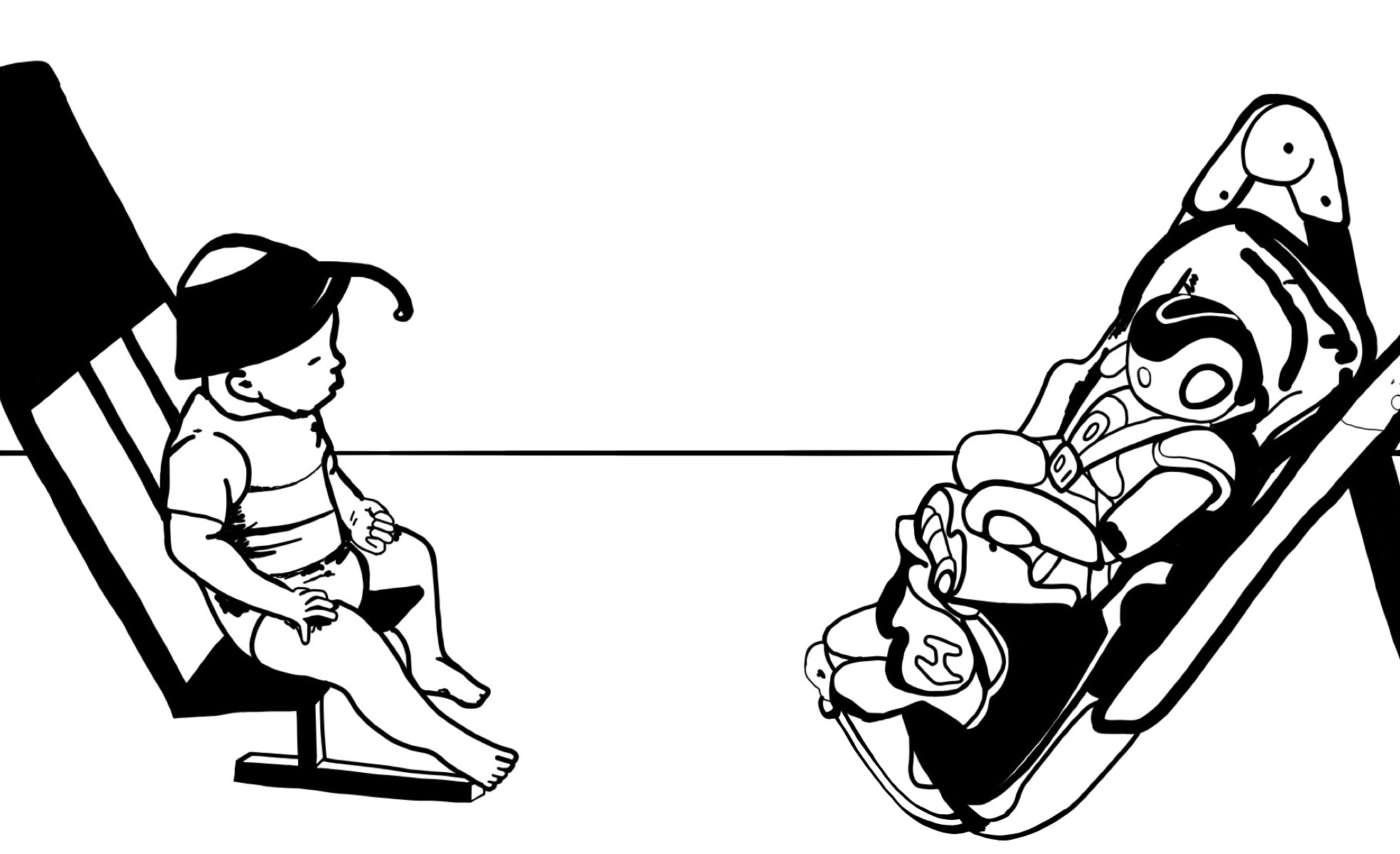Infant Motion Interventions
Limited options are available for young children who require motion interventions. We view assistive robots as a key opportunity for improvement in this space. This work is funded by the NSF National Robotics Initiative (under award CMMI-2024950) and the Caplan Foundation.

Problem
As improvements in medicine lower infant mortality rates, more infants with neuromotor challenges survive past birth. The motor, social, and cognitive development of these infants are closely interrelated, and challenges in any of these areas can lead to developmental differences. At the same time, early motor interventions are often highly limited or postponed until a later age.
Solution
The combination of socially assistive robotics and infant tendencies including contingency learning and imitation opens up possibilities for early interventions during which robots can model desired infant behavior and/or reward the practice of these behaviors. This concept can apply in seated and mobile interventions for children with a variety of needs. Robots show promise for extending the abilities of intervention specialists; by designing robot interventions with experts from physical therapy, health science, kinesiology, and other areas, we can create scalable and appropriate interventions with the potential to lower the cost and raise the availability of early targeted motor practice.
People
- Ameer Helmi (PhD Student)
- Rafael Morales (MS Student)
- Susan Liu (MS Student)
- Lara Rupnawar (Undergraduate Researcher)
- Courtney (CJ) Chavez (Undergraduate Researcher)
Publications
- Ameer Helmi, Connor Phillips, Fernando Castillo, Samuel W. Logan, and Naomi T. Fitter, "OverTrack: Overhead Camera Tracking Tool for Child-Robot Interaction," Proceedings of the 2nd Workshop on Social Robot Navigation: Advances and Evaluation, held in conjunction with the IEEE/RSJ International Conference on Intelligent Robots and Systems (IROS), Detroit, MI, USA, 2023. [BibTeX] [PDF]
- Rafael Morales Mayoral, Ameer Helmi, Shel-Twon Warren, Samuel W. Logan, and Naomi T. Fitter, "Robottheory Fitness: GoBot’s Engagement Edge for Spurring Physical Activity in Young Children," Paper accepted to the IEEE International Conference on Intelligent Robots and Systems (IROS), Detroit, MI, USA, 2023. [BibTeX] [PDF]
- Ameer Helmi, Tze-Hsuan Wang, Samuel W. Logan, and Naomi T. Fitter, "Harnessing the Power of Movement: A Body-Weight Support System & Assistive Robot Case Study," Paper accepted to the IEEE International Conference on Rehabilitation Robotics (ICORR), Singapore, Singapore, 2023. [BibTeX] [PDF]
- Ameer Helmi, Lara Rupnawar, Samuel W. Logan, and Naomi T. Fitter, "Illuminating Engagement: Real-Time Thermal Imaging of Child Affect During Child-Robot Interactions," Proceedings of the International Consortium on Rehabilitation Robotics (ICORR), Late Breaking Abstract Poster Presentation, Singapore, Singapore, 2023. [BibTeX] [PDF]
- Ameer Helmi, Tze-Hsuan Wang, Christine Zhan, Kenneth Nys, Pico Sankari, Samuel W. Logan, and Naomi T. Fitter, "GoBot Throw: A Toy-Inspired Ball-Launching Robot For Child-Robot Interaction," Proceedings of the From Modelling to Understanding Children's Behaviour in the Context of Robotics and Social Artificial Intelligence Workshop, held in conjunction with the 2022 International Conference on Social Robotics (ICSR), Florence, Italy, 2022. [BibTeX] [PDF]
- Ameer Helmi, Lucas Dassonville, Christine Zhan, and Naomi T. Fitter, "GoBot Dance: An Air Dancer-Inspired Robot For Child-Robot Interaction," Proceedings of the From Modelling to Understanding Children's Behaviour in the Context of Robotics and Social Artificial Intelligence Workshop, held in conjunction with the 2022 International Conference on Social Robotics (ICSR), Florence, Italy, 2022. [BibTeX] [PDF]
- Ameer Helmi, Kristen Koenig, and Naomi T. Fitter, "A Model Child? Behavior Models for Simulated Infant-Robot Interaction," Proceedings of the International Conference on Social Robotics (ICSR), Florence, Italy, 2022. [BibTeX] [PDF]
- Ameer Helmi, Samantha Noregaard, Natasha Giulietti, Samuel W. Logan, and Naomi T. Fitter, "Let Them Have Bubbles! Filling Gaps in Toy-Like Behaviors for Child-Robot Interaction," Proceedings of the IEEE International Conference on Robotics and Automation (ICRA), Philadelphia, PA, USA, 2022. [BibTeX] [PDF]
- Joseline Raja Vora, Ameer Helmi, Christine Zhan, Eliora Olivares, Tina Vu, Marie Wilkey, Samantha Noregaard, Naomi T. Fitter, and Samuel W. Logan, "Influence of a socially assistive robot on physical activity, social play behavior, and toy-use behaviors of children in a free play environment: A within-subjects study," Frontiers in Robotics and AI, 2021. [BibTeX] [PDF]
- Ashwin Vinoo, Layne Case, Gabriela R. Zott, Joseline Raja Vora, Ameer Helmi, Samuel W. Logan, Naomi T. Fitter, "Design of an assistive robot for infant mobility interventions," Paper accepted to the IEEE International Conference on Robot and Human Interactive Communication (RO-MAN), Vancouver, Canada (remote), 2021. [BibTeX] [PDF]
- Ameer Helmi and Naomi T. Fitter, "Lights, camera, action! Evaluating robot reward behaviors in free play with children," Proceedings of the Interdisciplinary Research Methods for Child-Robot Relationship Formation Workshop, ACM/IEEE International Conference on Human-Robot Interaction (HRI), Boulder, CO, USA (remote), 2021. [BibTeX] [PDF]
- Ameer Helmi and Naomi T. Fitter, "Using motion expert feedback to design models for infant-robot interaction," Proceedings of the 2020 ICSR Workshop on Child-Robot Interaction, International Conference on Social Robotics (ICSR), Golden, CO, USA (remote), 2020. [BibTeX] [PDF]
- Naomi T. Fitter, Rebecca Funke, José Carlos Pulido, Maja J. Matarić, and Beth A. Smith, "Toward predicting infant developmental outcomes from day-long inertial motion recordings," Transactions on Neural Systems and Rehabilitation Engineering, 2020. [BibTeX] [PDF]
- Naomi T. Fitter, Rebecca Funke, José Carlos Pulido, Lauren Eisenman, Weiyang Deng, Marcelo R. Rosales, Nina S. Bradley, Barbara Sargent, Beth A. Smith, and Maja J. Matarić, "Socially assistive infant-robot interaction: Using robots to encourage infant leg-motion," Robotics and Automation Magazine (RAM), 26(2):12-23, 2019. [BibTeX] [PDF]
- Rebecca Funke, Naomi T. Fitter, Joyce T. de Armendi, Nina S. Bradley, Barbara Sargent, Maja J. Matarić, and Beth A. Smith, "A data collection of infants’ visual, physical, and behavioral reactions to a small humanoid robot," Proceedings of the IEEE Workshop on Advanced Robotics and its Social Impacts (ARSO), Genova, Italy, 2018. [BibTeX] [PDF]
